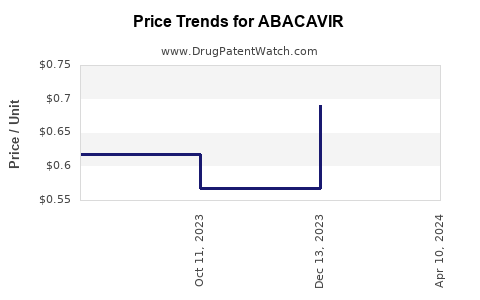Drug Price Trends for ABACAVIR
✉ Email this page to a colleague

Average Pharmacy Cost for ABACAVIR
| Drug Name | NDC | Price/Unit ($) | Unit | Date |
|---|---|---|---|---|
| ABACAVIR 300 MG TABLET | 50268-0049-12 | 0.59275 | EACH | 2024-11-20 |
| ABACAVIR 300 MG TABLET | 00378-4105-91 | 0.59275 | EACH | 2024-11-20 |
| ABACAVIR 300 MG TABLET | 00904-6874-06 | 0.59275 | EACH | 2024-11-20 |
| ABACAVIR 300 MG TABLET | 00904-6874-04 | 0.59275 | EACH | 2024-11-20 |
| ABACAVIR-LAMIVUDINE 600-300 MG | 69097-0362-02 | 1.61278 | EACH | 2024-11-20 |
| ABACAVIR 300 MG TABLET | 50268-0049-11 | 0.59275 | EACH | 2024-11-20 |
| >Drug Name | >NDC | >Price/Unit ($) | >Unit | >Date |
Best Wholesale Price for ABACAVIR
| Drug Name | Vendor | NDC | Count | Price ($) | Price/Unit ($) | Unit | Dates | Price Type |
|---|---|---|---|---|---|---|---|---|
| ZIAGEN 300MG TABLETS | ViiV HealthCare Company | 49702-0221-18 | 60 | 550.22 | 9.17033 | EACH | 2022-01-01 - 2026-08-14 | FSS |
| TRIUMEQ 600MG/50MG/300MG TAB | ViiV HealthCare Company | 49702-0231-13 | 30 | 1948.16 | 64.93867 | EACH | 2021-08-15 - 2026-08-14 | Big4 |
| EPZICOM 600MG/300MG TAB | ViiV HealthCare Company | 49702-0206-13 | 30 | 785.94 | 26.19800 | EACH | 2021-08-15 - 2026-08-14 | Big4 |
| TRIUMEQ PD | ViiV HealthCare Company | 49702-0258-37 | 90 | 1045.23 | 11.61367 | EACH | 2024-01-01 - 2026-08-14 | FSS |
| TRIZIVIR TABLETS | ViiV HealthCare Company | 49702-0217-18 | 60 | 1585.44 | 26.42400 | EACH | 2023-01-01 - 2026-08-14 | FSS |
| ZIAGEN ORAL SOLUTION | ViiV HealthCare Company | 49702-0222-48 | 240ML | 107.25 | 0.44688 | ML | 2022-01-01 - 2026-08-14 | Big4 |
| >Drug Name | >Vendor | >NDC | >Count | >Price ($) | >Price/Unit ($) | >Unit | >Dates | >Price Type |


